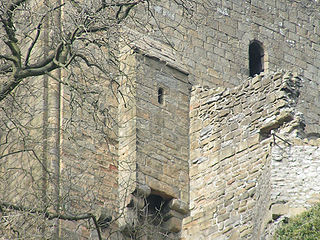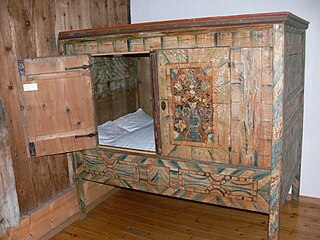
A closet is an enclosed space, with a door, used for storage, particularly that of clothes. Fitted closets are built into the walls of the house so that they take up no apparent space in the room. Closets are often built under stairs, thereby using awkward space that would otherwise go unused.

A futon is a traditional Japanese style of bedding.

A studio apartment, or studio condo also known as a studio flat (UK), self-contained apartment (Nigeria), efficiency apartment, bed-sitter (Kenya), or bachelor apartment, is a small dwelling in which the normal functions of a number of rooms – often the living room, bedroom, and kitchen – are combined into a single room.

A nightstand, alternatively night table, bedside table, daystand or bedside cabinet, is a small table or cabinet designed to stand beside a bed or elsewhere in a bedroom. Modern nightstands are usually small bedside tables, often with one or sometimes more drawers and/or shelves and less commonly with a small door. They are often used to support items that might be useful during the night, such as a table lamp, reading matter, cell phone, eyeglasses, tissues, a drink, or medication.

Garderobe is a historic term for a room in a medieval castle. The Oxford English Dictionary gives as its first meaning a store-room for valuables, but also acknowledges "by extension, a private room, a bed-chamber; also a privy".

A mattress is a large, usually rectangular pad for supporting a lying person. It is designed to be used as a bed, or on a bed frame as part of a bed. Mattresses may consist of a quilted or similarly fastened case, usually of heavy cloth, containing materials such as hair, straw, cotton, foam rubber, or a framework of metal springs. Mattresses may also be filled with air or water.

A bed is an item of furniture that is used as a place to sleep, rest, and relax.

A Murphy bed is a bed that is hinged at one end to store vertically against the wall, or inside a closet or cabinet. Since they often can be used as both a bed or a closet, Murphy beds are multifunctional furniture.

A chest of drawers, also called a dresser or a bureau, is a type of cabinet that has multiple parallel, horizontal drawers generally stacked one above another.

A cupboard is a piece of furniture for enclosing dishware or grocery items that are stored in a home. The term gradually evolved from its original meaning: an open-shelved side table for displaying dishware, more specifically plates, cups and saucers.

A walk-in closet or walk-in wardrobe (UK) or dressing room is typically a large closet, wardrobe or room that is primarily intended for storing clothes, footwear etc., and being used as a changing room. As the name suggests, walk-in closets are closets sufficiently big as to allow one to walk into them to browse through the items. It is often a small room with wall-mounted cabinet, shelf and drawers, and these can either be with or without doors. Walk-in closets often do not have doors in front of shelves, which can give a better overview of the clothes, but also leads to more dust. When the walk-in closet is large enough for dressing and undressing, the wardrobe is often also equipped with one or more mirrors. The room should also have good lighting, and a bench or chair can be handy. A dressing table is sometimes also found in the walk-in closet, and such dual use can relieve congestion around other rooms such as bathrooms.

Housing in Japan includes modern and traditional styles. Two patterns of residences are predominant in contemporary Japan: the single-family detached house and the multiple-unit building, either owned by an individual or corporation and rented as apartments to tenants, or owned by occupants. Additional kinds of housing, especially for unmarried people, include boarding houses, dormitories, and barracks.

A chifforobe, also chiffarobe or chifferobe, is a closet-like piece of furniture that combines a long space for hanging clothes with a chest of drawers. Typically the wardrobe section runs down one side of the piece, while the drawers occupy the other side. It may have two enclosing doors or have the drawer fronts exposed and a separate door for the hanging space.
A wardrobe or armoire or almirah is a standing closet used for storing clothes. The earliest wardrobe was a chest, and it was not until some degree of luxury was attained in regal palaces and the castles of powerful nobles that separate accommodation was provided for the apparel of the great. The name of wardrobe was then given to a room in which the wall-space was filled with closets and lockers, the drawer being a comparatively modern invention. From these cupboards and lockers the modern wardrobe, with its hanging spaces, sliding shelves and drawers, evolved slowly.

In a building or ship, a room is any enclosed space within a number of walls to which entry is possible only via a door or other dividing structure. The entrance connects it to either a passageway, another room, or the outdoors. The space is typically large enough for several people to move about. The size, fixtures, furnishings, and sometimes placement of the room within the building or ship support the activity to be conducted in it.

The Suntop Homes, also known under the early name of The Ardmore Experiment, were quadruple residences located in Ardmore, Pennsylvania, and based largely upon the 1935 conceptual Broadacre City model of the minimum houses. The design was commissioned by Otto Tod Mallery of the Tod Company in 1938 in an attempt to set a new standard for the entry-level housing market in the United States and to increase single-family dwelling density in the suburbs. In cooperation with Frank Lloyd Wright, the Tod Company secured a patent for the unique design, intending to sell development rights for Suntops across the country.

A box-bed is an enclosed bed made to look like a cupboard, half-opened or not. The form originates in western European late medieval furniture.

The President's Bedroom is a second floor bedroom in the White House. The bedroom makes up the White House master suite along with the adjacent sitting room and the smaller dressing room, all located in the southwest corner. Prior to the Ford Administration it was common for the President and First Lady to have separate bedrooms. Until then, this room was used mostly as the First Lady's bedroom; however, it was the sleeping quarters for President Lincoln.

A cabinet is a case or cupboard with shelves and/or drawers for storing or displaying items. Some cabinets are stand alone while others are built in to a wall or are attached to it like a medicine cabinet. Cabinets are typically made of wood, coated steel, or synthetic materials. Commercial grade cabinets usually have a melamine-particleboard substrate and are covered in a high pressure decorative laminate, commonly referred to as Wilsonart or Formica.



























